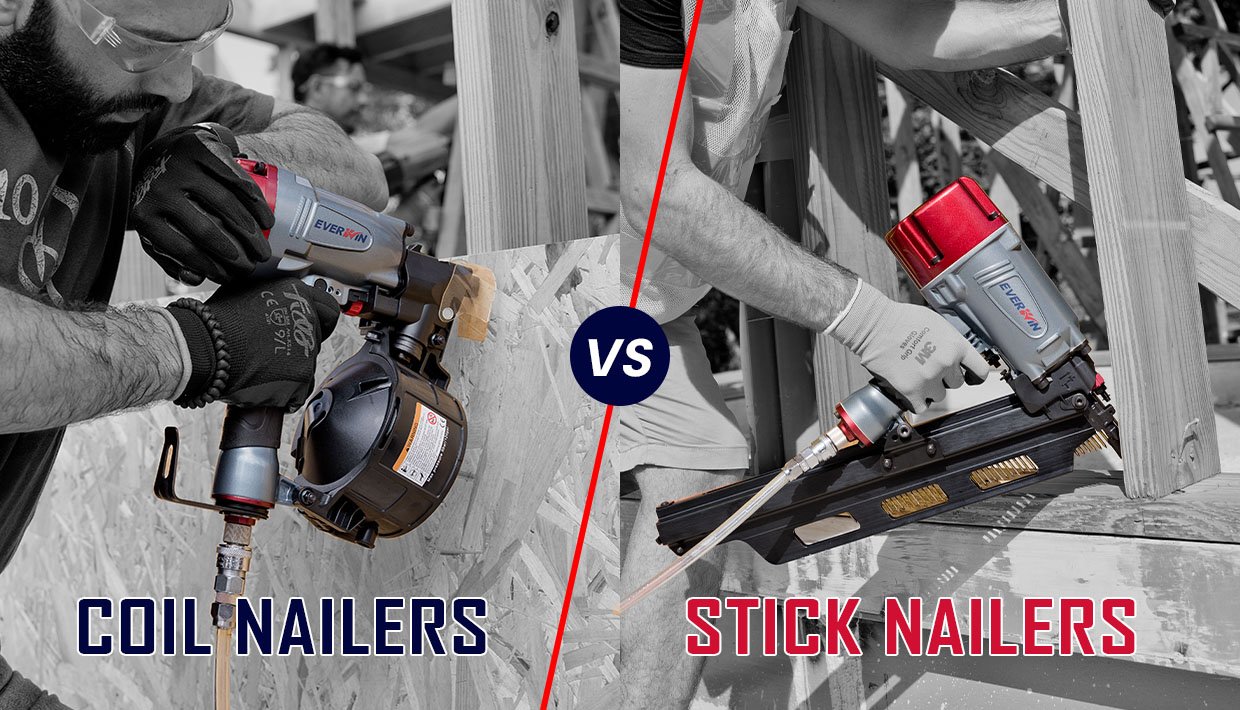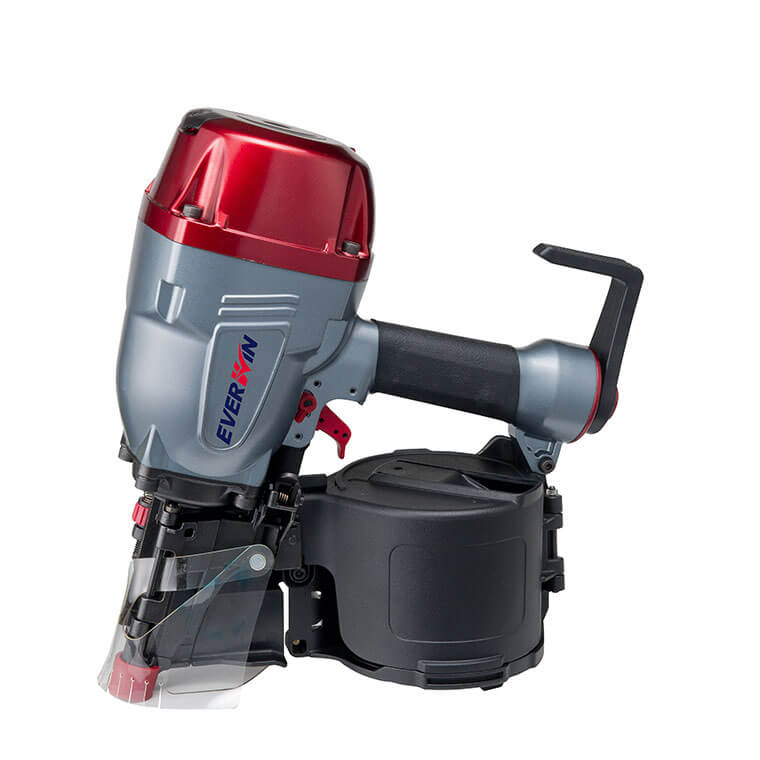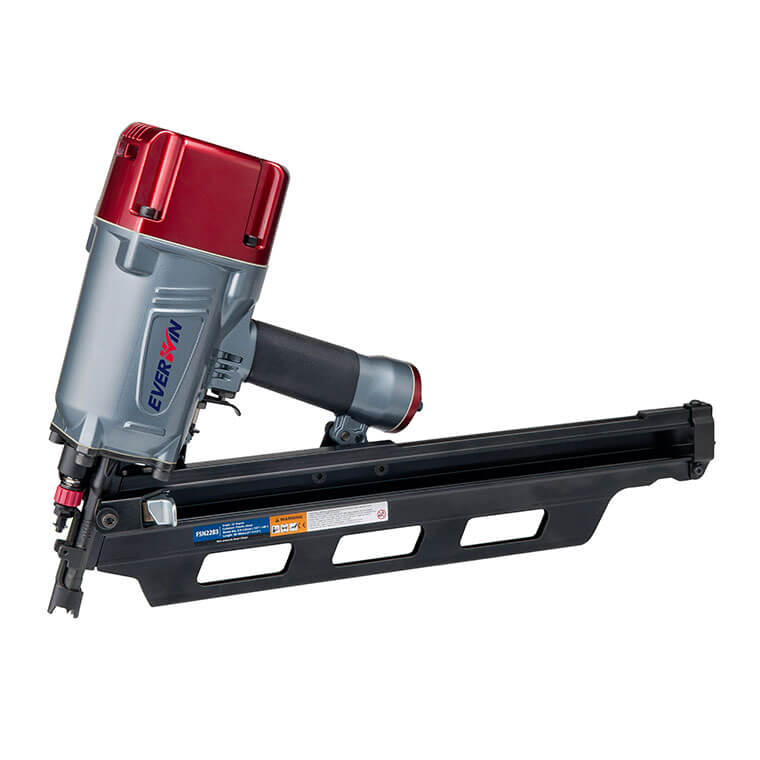
A Comparison between Coil Framing Nailers and Stick Nailers
Which is better between a coil framing nailer and a stick framing nailer? This has always been a question for the ages. Big carpentry work usually require very heavy usage of nails. Using hundreds to even thousands of nails is fairly common depending on the scale of the project. Hammering these nails manually is always an option but not an efficient one. In this case, either a coil framing nailer or stick nailer would be ideal. So here it comes: which one is better? Let us find out.
Coil Framing Nailer vs Stick Nailer
Both types of construction nailer are frequently seen on job sites and are used for framing. Even though coil nailers are not used as often as stick nailers when it comes to framing, they are still a very versatile tool, nonetheless. See EVERWIN’s range of framing nailers.
What is a Coil Nailer?

Coil nailers for framing /siding /roofing generally hold 200~300 nails in their canister, depending on the type and size of the nails. The most common types of pneumatic coil nail used are:
- Framing nails
- Sheathing nails
- Roofing coil nail
Since the loading capacity is high, users do not have to reload that often, which in turn saves a lot of time. Our PTIA Award-Winning SCN51 is perfect for a wide range of siding and fencing type applications.
Coil nailers are oftentimes compact, meaning using them in tight spaces is not a problem. However, with their amazing maneuverability comes a downside: weight.
A fully loaded canister can increase the weight of the tool by a large margin and create fatigue for the users quite easily. As a result, a stick nailer is recommended for overhead work due to its lower weight.
That being said, EVERWIN offers the lightest framing coil nailer in the industry with the award-winning FCN90LB, featured in several articles including a review done by Tools of the Trade.
What is a Stick Nailer?

Framing nailer, aka a First-fix nailer are great on overhead applications, however, users will have to make sure that the nail has the right angle and collation style to fit the nailer.
A stick nailer consists of magazines that hold 25~90 nails each, so there is a lot more reloading to do. However, in exchange, it also brings less fatigue due to its lower weight. The common stick nail will be able to hold the following nail types:
- 21 degree nails
- Plastic collated round head nails-17, 18, 21, 22 degree
- 28 degree clipped head stick nails
- Wire collated D-head nails between 27 degrees ~ 28 degrees
- Paper collated D-head or offset head nails between 30 degrees ~ 34 degrees
That being said, users will need to follow local rules and codes which may potentially rule out the usage of certain nail types. As a result, it is absolutely important to pay attention to the acceptable nail types when you’re making your purchase.
Led by the FSN2283A and the FSN3490, EVERWIN offers a complete series of framing stick nailers that perfectly balances power and weight.
Key Comparisons
While the functions of these two pneumatic nailers are the same, their designs and features are quite different. Some of the key comparisons are shown below.
- Weight- A fully loaded coil nailer can easily weigh ten pounds and even more depending on the model. As a result, having to hold one of these overheads for a long time can easily bring fatigue. Stick nailers weigh much less due to their smaller magazine capacity and in turn also creates less fatigue when operated over a long period of time.
- Capacity- If you are working on something that requires a lot of nails, you would not want to have to reload every 50 nails. In this case, a coil nailer would fit better for your job due to its large loading capacity.
- Loading- Coil nailers use round canisters with a loop design that allows for rapid firing and minimizes jams. Stick nailers on the other hand use magazines with nail strips that increases the overall length of the tool.
- Nail pricing- In terms of prices, the nails for stick nailers are oftentimes far more expensive than those of coil nailers coil nailers are not that dependent on certain angle nails and hence they are easier to fill.
- Jamming- Stick nailers are more prone to jamming compared to coil nailers due to its magazine design.
Choosing the right model is as subjective as it gets; there is certainly no right or wrong answer. Nonetheless, we recommend a coil nailer due to the tool’s compactness and maneuverability if the working area is small and there is less space to operate.
A good example of a nice blend between compactness and power, backed by Pro Tool Reviews, is EVERWIN’s FCN90B coil nailer.
But whatever it is you seek, know that EVERWIN has you covered with the right nailer built with quality.
Conclusion
We hope with the better understanding of the differences between pneumatic coil nailer and sticker nailers you have gained after reading this article, you will be more prepared for your future projects.
# # #
About EVERWIN PNEUMATIC EVERWIN® was founded in 2012 by a group of American and Taiwanese pneumatic tool experts, each boasting decades of experience and success in the world of pneumatic fastening. They founded the company with one shared goal in mind— to “build a brand the fastening industry can rely on for consistency and efficiency.” EVERWIN quickly garnered recognition as a premier brand for industrial fastening tools. With strong roots in the industrial market, EVERWIN has a different take on construction nailers and staplers from most price-driven manufacturers today.
